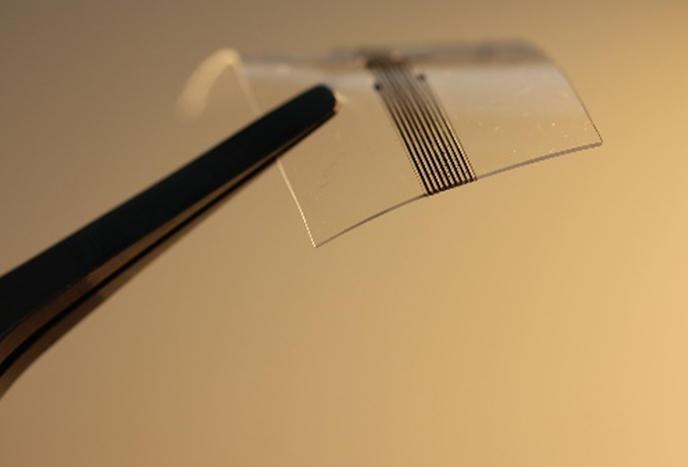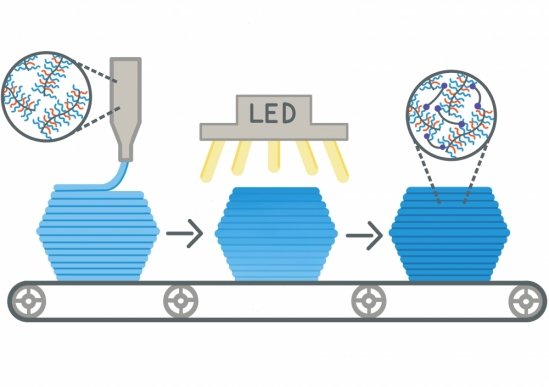Researchers from the University of California at Santa Barbara (UC Santa Barbara) have developed a 3D printable “bottlebrush” elastomer with softness and elasticity resembling that of human tissue.
Postdoctoral researchers Renxuan Xie and Sanjoy Mukherjee stumbled across the new elastomer by accident while trying to develop a material for a different project. After observing its super-soft and shape-holding properties, they realized they could 3D print the elastomer using direct ink writing (DIW) to create inks, before returning the elastomer to its solid form by applying UV light.
According to Xie and Mukherjee, being able to 3D print bottlebrush elastomers makes it possible to harness their unique mechanical properties for applications such as biomimetic tissue and high-sensitivity electronic devices like touch pads, sensors, and actuators, which require close control over an object’s dimensions.
Christopher Bates, an assistant professor at UC Santa Barbara and laboratory leader, said of the accidental discovery:
“When we saw this really well-defined stress, it dawned on everyone collectively that we could 3D print it, and that would be cool, because none of the 3D printable materials we know of have this super-soft property.”
The uniquity of bottlebrush elastomers
Bottlebrush polymers have been around for more than two decades, and differ from conventional elastomers, or rubbers, as a result of their structure. While conventional elastomers are stiffer than many biological tissues due to being made up of long and entangled linear molecules, bottlebrush polymers have additional polymers attached to their linear backbone. This structure looks similar to that of a bottlebrush one may find in a kitchen, hence the name, and enables the polymer to form extremely soft elastomers.
As far as the researchers are aware, despite being around for years bottlebrush polymers haven’t been 3D printed before, making UC Santa Barbara’s new material all the more unique.
“The field has exploded in the past ten years thanks to advances in synthetic chemistry that provide exquisite control over the size and shape of these unique molecules,” continued Bates. “These super-soft elastomers might be applicable as implants. You may be able to reduce inflammation and rejection by the body if the mechanical properties of an implant match native tissue.”
Soft and flexible polymers have been previously utilized in the development of 3D printed implants, an example of which is the production of a soft neural implant by researchers at Massachusetts Institute of Technology (MIT) which conforms to the contours of the brain to monitor activity over long periods of time. The use of 3D printed flexible polymer electronics can potentially provide a softer, safer, and faster alternative to existing metal-based implants.
Elsewhere, soft materials and electronics have also been combined to develop a 3D printed prototype neural implant with the potential to treat nervous system injuries, such as paralysis, and in the creation of a 3D printed biosensor for the wireless monitoring of blood flow. Soft polymer-based 3D printing materials are also used within the dental sector for the production of clear aligners, flexible dentures, and crowns.

3D printing the bottlebrush elastomer
The initial discovery was centered around the self-assembly of bottlebrush polymers at the nanometer length scale. Categorized as a yield-stress-fluid, the material begins as a semi-soft solid that holds its shape, similar to butter, but liquifies once sufficient pressure is applied. This meant that the researchers could print the material in ink form via a DIW 3D printing process.
As the material is capable of holding its shape for hours, it can be tuned to flow under various amounts of pressure, such as when vibration is present, to suit the desired processing conditions without impacting the structural stability of the printed part. Once the object had been printed, the researchers exposed it to UV light in order to activate crosslinkers within the ink formulation. These crosslinkers link up the bottlebrush polymers to form a super-soft elastomer that becomes a permanent solid, meaning it will no longer liquify under pressure.
Xie explained: “We start with long polymers that are not crosslinked. That allows them to flow like a fluid. But, after you shine the light on them, the small molecules between the polymer chains react and are linked together into a network, so you have a solid, an elastomer that, when stretched, will return to its original shape.”
The softness of a material is measured in terms of its modulus – in essence, how easily it is stretched – and for most elastomers this can be compared to that of a rubber band. Xie and Mukherjee’s material boasts a modulus one thousand times smaller than that of a rubber band, meaning it is extremely soft and stretchy. In fact, the bottlebrush elastomer can be stretched between three and four times its length.

A “pure” polymer
Another factor that makes the researchers’ material unique is that it contains no water or other solvent in order to make it artificially softer. Conventional polymers are reliant on containing the right amount of water in order to maintain their structures, however the bottle brush elastomer is all solid, so its form will not change.
“People often add solvent to liquify a solid so that it can be squeezed out of a nozzle,” Xie added. “But if you add solvent, it has to evaporate after printing causing the object to change its shape or crack.”
The researchers believe the solvent-free manufacturing process is particularly advantageous for enabling the printing process to be as clean and easy as possible. The resulting material “feels very much like human tissue”, and has a variety of potential applications within biomimetic tissue and high-sensitivity electronics.
Subscribe to the 3D Printing Industry newsletter for the latest news in additive manufacturing. You can also stay connected by following us on Twitter and liking us on Facebook.
Looking for a career in additive manufacturing? Visit 3D Printing Jobs for a selection of roles in the industry.
Featured image shows from left: the unlinked polymer ink, infrared light being applied to activate the crosslinks, and the final product — a super-soft, super-elastic crosslinked elastomer. Image via Isabelle Chabinyc/UC Santa Barbara.



